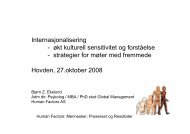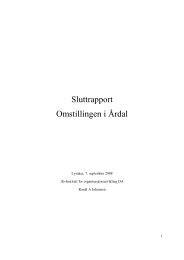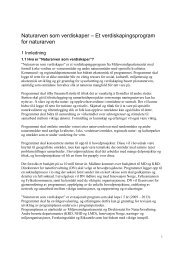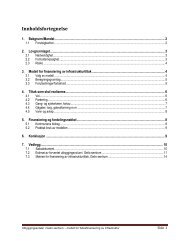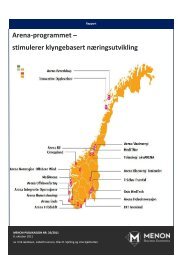Evaluering av seks NCE prosjekter - Innovasjon Norge
Evaluering av seks NCE prosjekter - Innovasjon Norge
Evaluering av seks NCE prosjekter - Innovasjon Norge
You also want an ePaper? Increase the reach of your titles
YUMPU automatically turns print PDFs into web optimized ePapers that Google loves.
- Econ Pöyry -<br />
<strong>Evaluering</strong> <strong>av</strong> <strong>seks</strong> <strong>NCE</strong> <strong>prosjekter</strong><br />
innovative because they compete and collaborate with each other and because of certain<br />
externalities that they benefit from. In that sense, both strengthened networks on the one<br />
hand and competence building and knowledge sharing on the other can be considered<br />
relevant preconditions for future innovation activities. Internationalisation in the sense<br />
of increased global competitiveness is a possible long term effect of a stronger cluster<br />
but necessarily directly linked to a specific activity in the project. International<br />
attractiveness and network building h<strong>av</strong>e been subject to some efforts. Mostly, however,<br />
the challenge identified by the clusters is that of maintaining local relations in a context<br />
of increasing internationalisation, and not one of establishing more international<br />
contacts.<br />
All six projects h<strong>av</strong>e made good progress towards objectives and reached some<br />
important milestones. Most important among these are the establishment of industry<br />
relevant study programs, expanded research agendas and strengthened infrastructure for<br />
R&D, along with increased <strong>av</strong>ailability of exchange and learning events. Feedback from<br />
stakeholders is generally positive. It is difficult to make objective assessments about<br />
effectiveness due to a lack of monitorable indicators and the fact that projects are still in<br />
an early phase.<br />
Projects are efficiently managed by making use of existing structures rather than<br />
establishing new ones. Two of the projects use local R&D facilities; one is located in<br />
the regional business council and two in the existing facilities for innovation and<br />
incubation. Only one of the projects has built a management unit from scratch yet<br />
managed to keep it lean and efficient. Such arrangements allow for synergies with other<br />
programs and prevent the establishment of expensive organizational units. Projects also<br />
enjoy a high degree of flexibility both from the <strong>NCE</strong> programme centrally and from<br />
their members locally. This flexibility is logical and appropriate, however needs to be<br />
offset by structured follow-up through robust indicators and reporting systems.<br />
Challenges going forward relate to a need to strengthen the focus on and appliance of<br />
R&D as well as strengthening the infrastructure for innovation. The former refer to<br />
plans to establish a shared research facility in one cluster, the need to tap into existing<br />
research centres in two, and following up in research staff investments in a fifth. The<br />
latter refers to facilitating access to capital as well as technical support for new<br />
businesses. The <strong>NCE</strong> projects also need to strike a balance between ambitious projects<br />
with expected long term effects on the one hand and more low hanging fruits that can<br />
demonstrate the value of collaboration and underpin commitment to projects in the<br />
shorter term on the other. The relevance of competence development to overall program<br />
goals could be emphasized by programme management.<br />
There is a need for an operational monitoring and reporting system. Indicators lack<br />
correlation with program and project objective. Indicators also to a large extent relate to<br />
factors outside the control of the projects. While the programme draws from theoretic<br />
approaches, its management and results monitoring need to be practical. A good<br />
monitoring system should function as a management tool. For this to be possible,<br />
projects could clarify and enhance their articulation of objectives: these objectives<br />
should be accompanied by monitorable indicators. While the overall goal may go in the<br />
direction of increased growth and competitiveness, objectives should be within the<br />
realm of what the projects can realistically influence. A revised monitoring system<br />
should reduce the number of indicators from 72 to about 10, and should allocate greater<br />
data collection responsibility with local project leaders.<br />
4









